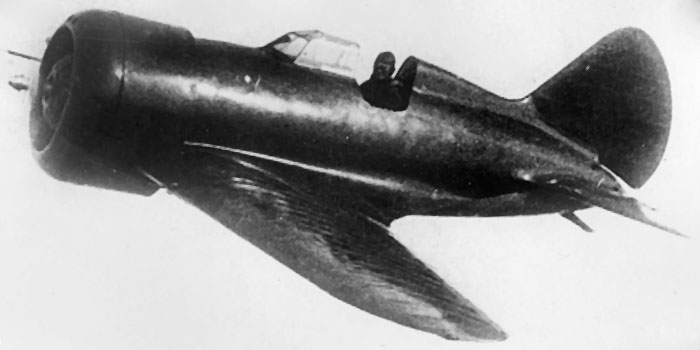
This photo probably shows the prototype TsKB-12 flying in its modified form during a series of test flights made in April 1934. The tests were made with the canopy open and the pilot's door removed to allow to bail out quickly in case of need. Strangely, we see that the opening was extended to the right side too.
The photo shows the removal of the OP-1 gunsight and of the wing armament, that were reinstalled later, and the military livery. Red stars are not visible, but it is likely that they were, of the type with the black outline and circle inside as on I-15bis and 153.
Image from Istrebitel I-16 of Maslov
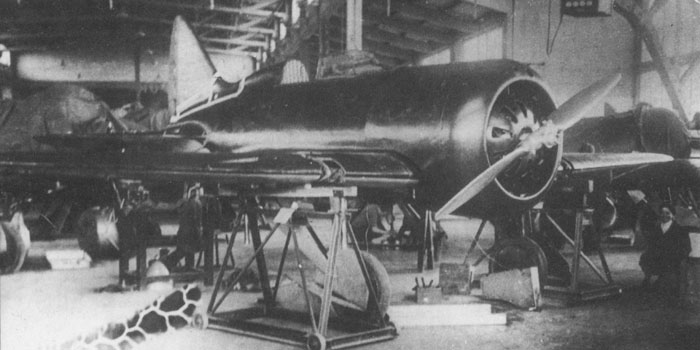
The I-16 Type 4 was the first production version of 1934, broadly similar to TsKB-12 prototype, but the name 'Type 4' was not attributed immediately.
The plane was equipped with M-22 engine, a Soviet copy of the British Bristol Jupiter VI built in GAZ-29 in Aleksandrovsk. It was fitted with the V-22 fixed pitch propeller that turned clockwise, differently from successive Types engined with M-25/62/63 of Shvetsov where it turned counterclockwise.
It was armed with two ShKAS machine guns in the wings, firing outside the disk of the propeller, just as the prototype.
The plane was hurrily put into production, despite not all problems had been resolved, as an interim version before the availability of the more advanced M-25 engine.
The codes of the planes built in GAZ-39 started with 123901 arriving up to 123958; the start '12' was a clear reference to the TsKB-12, already known as I-16; 39 was the number of the factory, followed by the individual number of each plane
Image from I-16 in action-Squadron Signal
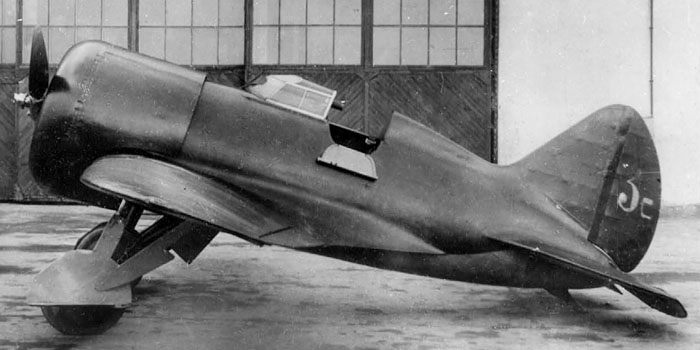
The name 'Type 4' was given in GAZ-21, because it was the fourth type of plane that they had in production after the I-5, JAI-1 and I-14 . The name was preserved by the Air Force also for the planes built in GAZ-39. So, There was not any I-16 Type 1, 2 or 3.
Right: photo of TsKB-12/Type 4 s/n 123903 in the GAZ-39 at Khodynka, the third production plane. This factory produced 58 TsKB-12/Type 4 in 1934, then the production was moved in GAZ-21; of these planes, s/n 123954 was completed as the prototype of Type 5 with Cyclone engine.
The planes built in GAZ-39 were distinguishable because the upper and side part of the cowling was longer than both the prototype and the Type 4 built in GAZ-21. Besides the production planes were equipped with foldable covers of the wheels, absent on the prototype.
This plane had a olive green/medium blue military livery; the red stars are scarcely visible.
It was publicly shown over Red Square and Tushino, and delivered to units in mid 1935; it remained into production for all the 1935.
Image from Istrebitel I-16 of Maslov
Below: again plane 123903. The photo shows that it was unarmed, and that the blisters for landing flares behind the right wingtip were preserved on very early production planes. The pitot probe was normal, instead of the forked one of the prototype. Two holes on the front of the cowling were not for weapons, but as air intakes for the supercharger.
Image from Polikarpov I-16 fighter of Gordon and Dexter
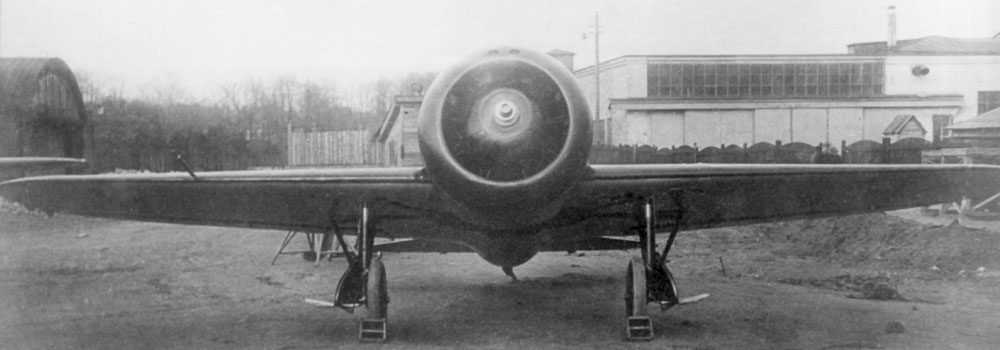
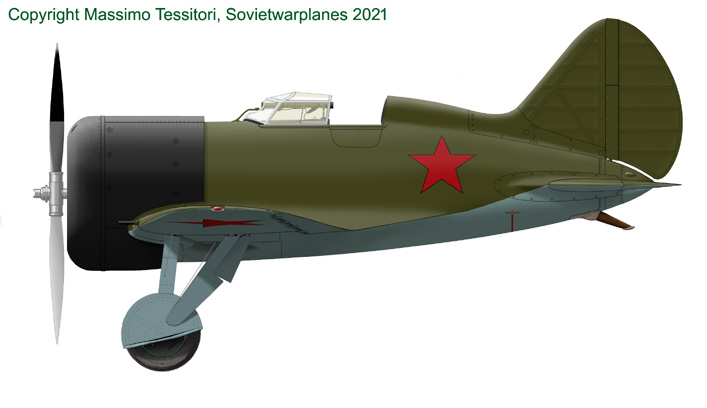
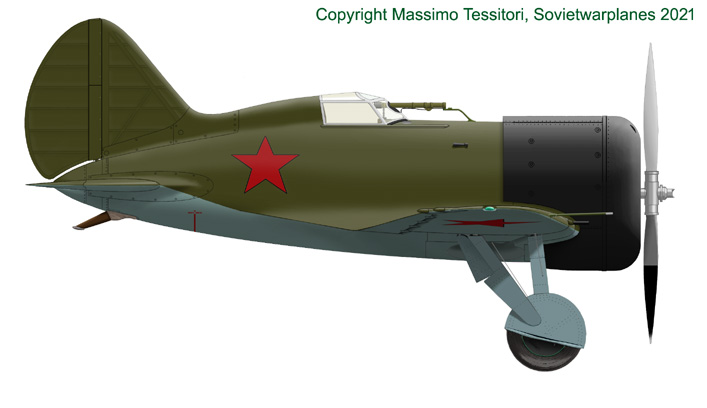
When compared to the TsKB-12 prototype in its final configuration, the early production TsKB-12/I-16 Type 4 of GAZ-39 visually differed for:
- deletion of two small blister for the ShVAK on the upper surface of the wings;
- addition of a folding cover for the wheels
- normal pitot probe instead of a forked one;
- fastening wires between the fin and the stabilizers could have been added in a second time as on GAZ-21 produced Type 4.
When compared to the later and better known Type 5, the early production Type 4 of GAZ-39 differed for:
- engine M-22 instead of M-25;
- NACA cowling, approximately cylindrical and opened on the front;
- two holes on the front of the NACA as air intakes;
- V-22 fixed pitch propeller turning clockwise, no spinner;
- no visible exhaust tubes;
- ShKAS with shorter fairings;
- a small bulge on the upper left part of the tail cone, present on Type 4 only, not on successive types;
- tail fin twisted of 2° to the right to compensate the torque of the propeller, that turned clockwise (the fin of all successive versions was twisted 2° to the left, and their propeller turned counter-clockwise);
- long plates covering the hinge line between fin and rudder, instead of the small plates on the hinges of Type 5;
- long ailerons, each with 4 protruding hinges on the lower surface, and wide gaps between wings and ailerons that disappeared on all successive versions;
- the rear of the tip of the right wing had metallic skinning and two blisters with landing torches protruding on the rear edge, at least on the first planes produced; this characteristic disappeared soon, but it's not clear if all the 58 planes of GAZ-39 had it;
- 100x750 mm wheels (as on Type 5 of 1936, then 150x750 mm wheels were adopted on later versions starting from the spring 1937);
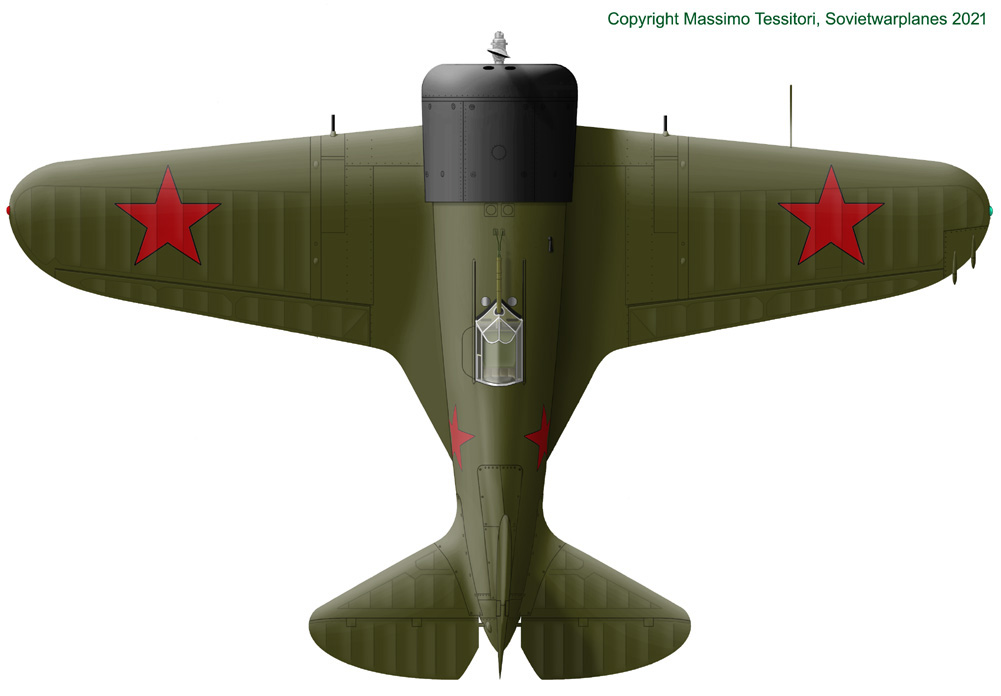
Above: top view of the early TsKB-12/Type 4 of GAZ-39.
Note the fin turned to the right, contrarily to all successive versions, and the small bulge on the left side of the tail cone.
Below: bottom view .
Note the protruding hinges of the ailerons, a characteristic lost on successive types.
The fuses for landing flares and the metallic skinning behind the right wing soon disappeared, but it is not clear if all 58 planes produced in GAZ-39 had them.
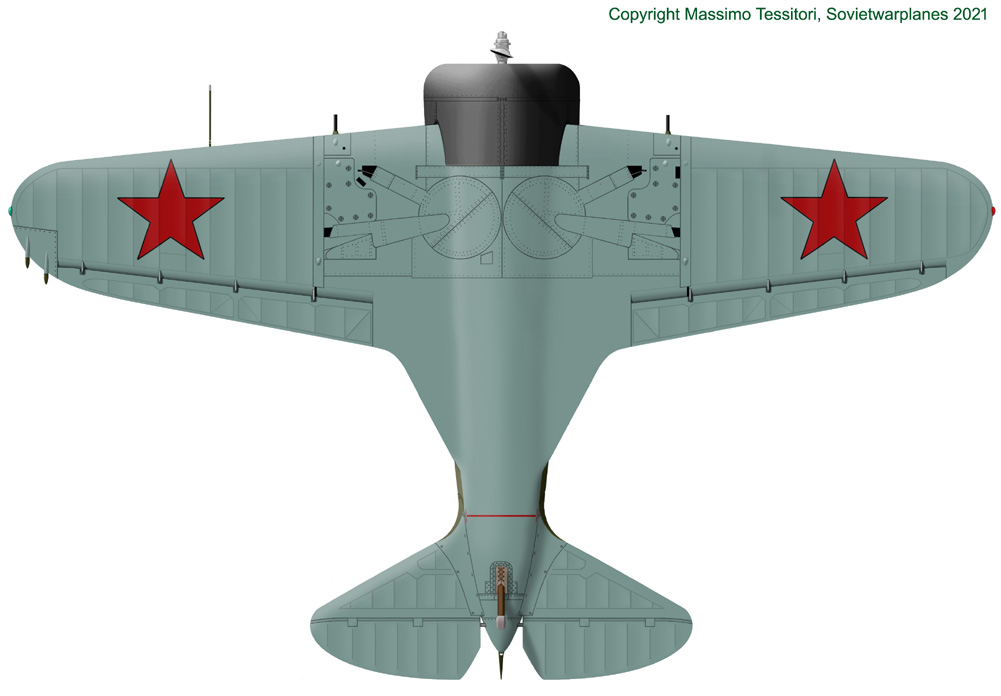
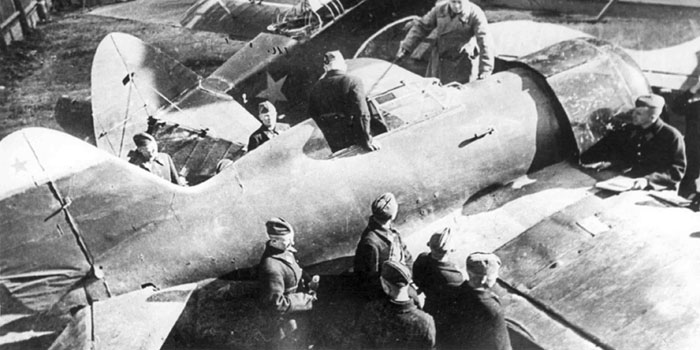
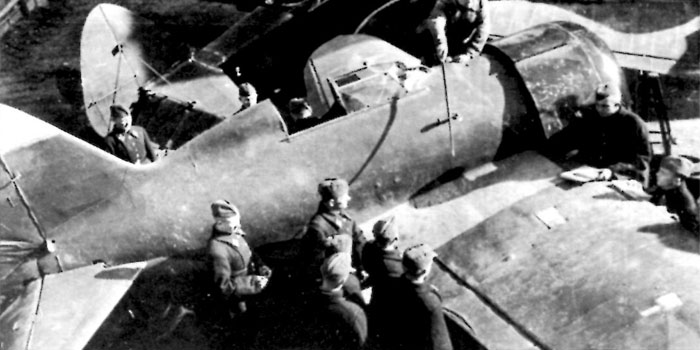
The name 'Type 4' was given in GAZ-21, because it was the fourth type of plane that they had in production. The name was preserved by the Air Force and extended to the planes built in GAZ-39. So, There was not any I-16 Type 1, 2 or 3.
The first plane of GAZ-21, s/n 4211, was delivered on August 16, 1934, but the massive production started only in October and about 50 planes were delivered within the year 1934, all other ones in 1935. Serial numbers end with 421505, suggesting a production of 505 planes ( many sources say 400).
The photos on the left show a Type 4built in GAZ-21 in a flight school. The planes produced in this factory are easily recognizable because their cowling was shorter on the rear above the wings plan when compared to the TsKB-12s produced in GAZ-39.
The plane looks worn, slightly damaged , deprived of its propeller, armament and gunsight. A lighter cover was put on the wingroot to preserve the paint from excessive wearing due to boots.
The photos show a worn olive green-light blue military livery with a black cowling, typical I-16s up to the beginning of 1938.
The white tail tip with a small red starlet and a thin line, perhaps blue, is evident.
The second image shows clearly the red stars on the wings; none is visible on the fuselage, but we can suppose that it was there. It is reported that a photo of a Type 4 showed that the red stars had a small red circle as on I-15bis and 153.
Images from I-16 in action-Squadron Signal and from Scalemodels.ru.
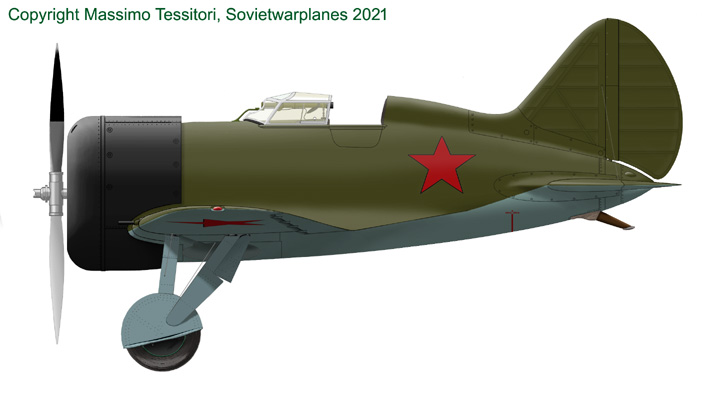
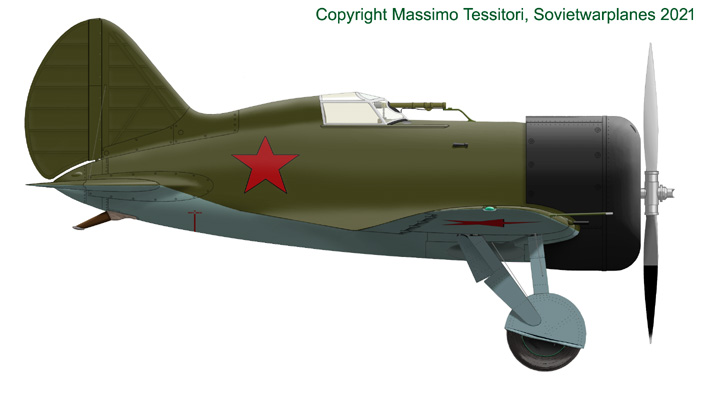
When compared to the early production I-16 Type 4 of GAZ-39, those produced in GAZ-21 visually differed for:
- deletion of the landing flares behind the right wingtip;
- engine cowling shorter on its top and sides rear;
- fastening wires between the fin and the stabilizers, perhaps added in a second time.
When compared to the later and better known Type 5, the Type 4 of GAZ-21 differed for:
- engine M-22 instead of M-25;
- NACA cowling, approximately cylindrical and opened on the front;
- two holes on the front of the NACA as air intakes;
- V-22 fixed pitch propeller turning clockwise, no spinner;
- no visible exhaust tubes;
- PV-1 7,62 machine guns instead of the ShKAS of the later types, and with shorter fairings where the barrels protrude from the wing leading edges;
- a small bulge on the upper left part of the tail cone, present on type 4 only, not on successive types;
- tail fin twisted of 2° to the right to compensate the torque of the propeller, that turned clockwise (the fin of all successive versions was twisted 2° to the left, and their propeller turned counter-clockwise);
- long plates covering the hinge line between fin and rudder, instead of the small plates on the hinges of Type 5;
- long ailerons, each with 4 protruding hinges on the lower surface, and visible gap between wings and ailerons that disappeared on all successive versions;
- 100x750 mm wheels (as on type 5 of 1936, then 150x750 mm wheels were adopted on later versions starting from the spring 1937);
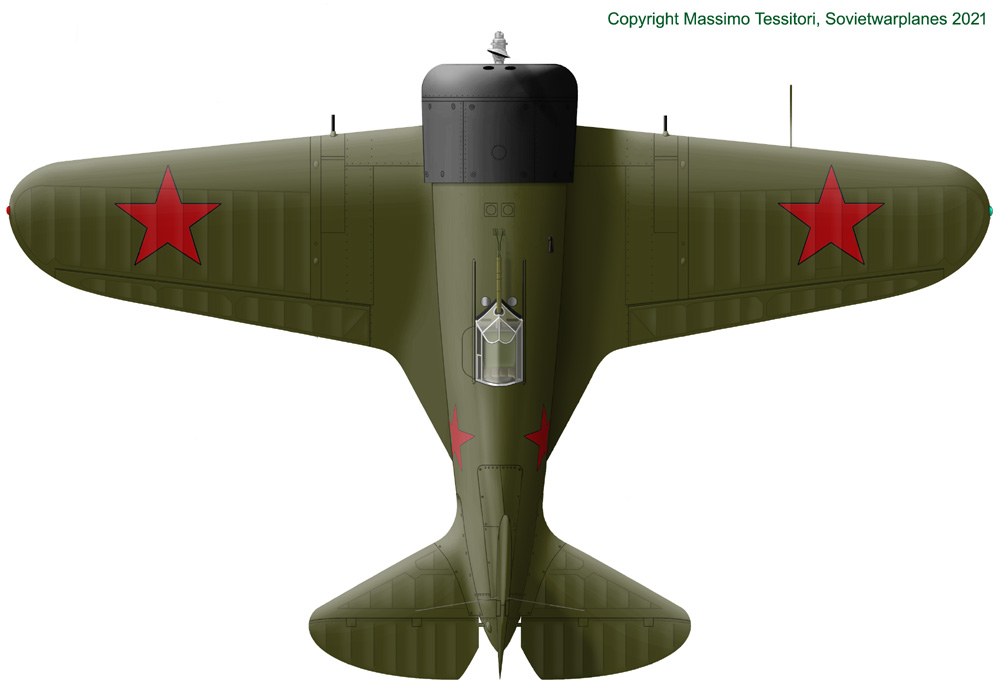
Above: top view of the mass-production Type 4 of GAZ-21.
The shorter cowling and the deletion of the blisters for landing flares behind the right wingtip is evident.
Note the fin turned to the right, contrarily to all successive versions, and the small bulge on the left side of the tail cone.
Note also the fastening wires between the fin and the stabilizers.
Below: bottom view.
Note the protruding hinges of the ailerons, a characteristic lost on successive types.
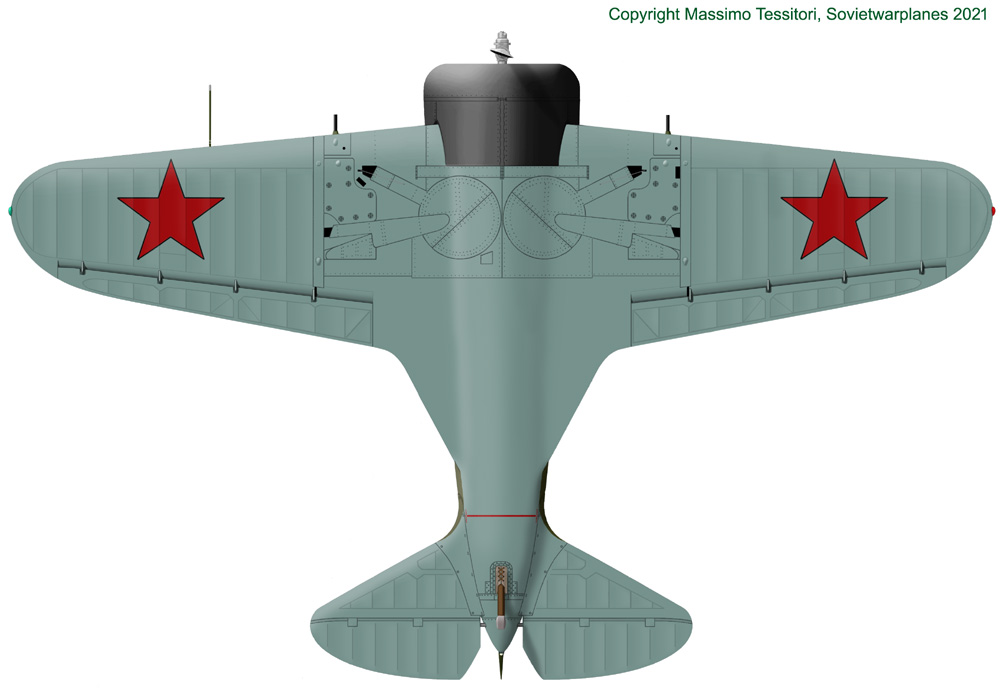
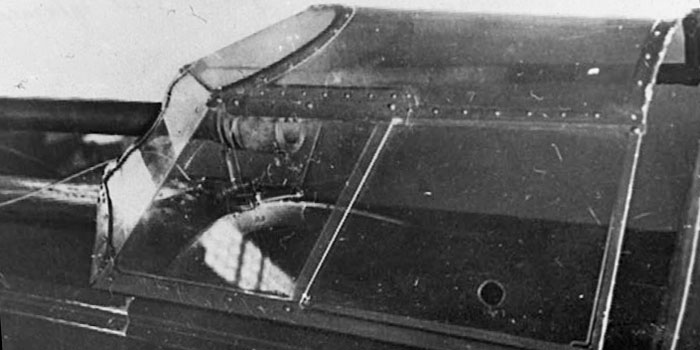
Shot of the canopy of the TsKB-12/Type 4. It opened by sliding forward, a thing that was not so easy and quick in flight.
The left guide of the sliding canopy was partially on the door of the left side; the door could open only with the canopy fully forward. So, the most of the pilots flew with the canopy slided forward to bail out quickly if needed.
It was made with panels of glass, while the curved one atop was of bended clear plastic.
The OP-1 telescopic gunsight passed through an opening on the front; this opening was larger than the tube; on Type 5 the gap was closed by a shield, probably of rubber, solidal to the telescope; the photos of Type 4 don't show such shield, but we can suppose that it was installed in a second time.
The transparent panel of the left side was composed of two parts, the rear one could slide forward to open a window; the right side was made of one piece instead.
Just in front of the closed windshield, two small circular windows on the fuselage gave some light to the instrument panel.
Image from Istrebitel I-16 of Maslov
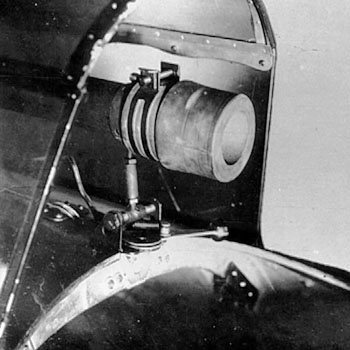
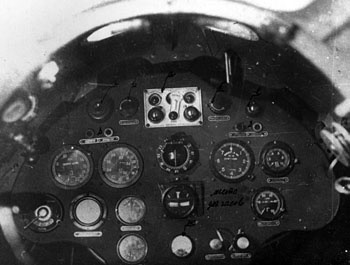
Left: detail of the OP-1 gunsight with the canopy in opened position. The inside was probably painted white as on the TsKB-15 (I-17), or very light grey.
The instrument panel of the TsKB-12/Type 4. The color doesn't look black, it could be dark emerald green as on the TsKB-15.
The light from the small circular windows is well recognizable.
Images from Istrebitel I-16 of Maslov

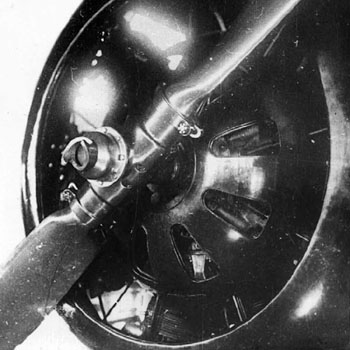
The tail cone of the TsKB-12/Type 4 was similar to that of later types, but had a drop-shaped blister on the left side.
At the end, there was a white navigation light.
Note the roughly circular openings for the shafts of the elevators and of the rudder, common to later versions.
Right: the front of the NACA cowling of the type 4 was fully opened on its front, completely different from that of the later types that was closed with 9 vents.
The engine was a M-22, a Soviet copy of the British Bristol Jupiter VI built in GAZ-29 in Aleksandrovsk.
Some images at https://karopka.ru/community/user/20051/?MODEL=425222
The V-22 propeller turned clockwise (differently from later types)
Images from Istrebitel I-16 of Maslov
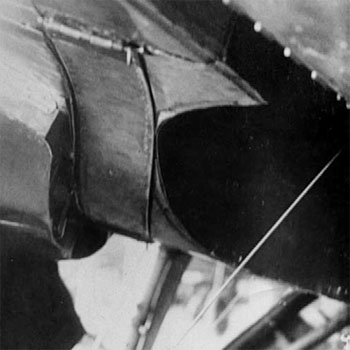
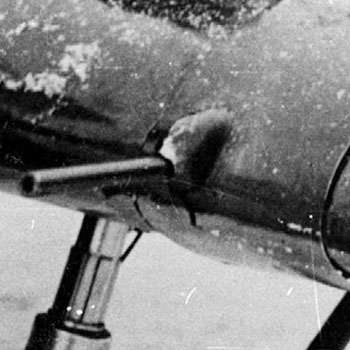
Left: image showing the lower rear gap between fuselage and cowling.
The images show also the landing gear bays (seemingly painted in black) and the cable for the manual retraction of the landing gear.
Between the cowling and the bay, we can see one of the hatches for the ammo boxes of two 7.62 mm machine guns in the wings.
Right: detail of the barrel of the ShKAS on the left wing. The blister seems a bit shorter than the one of the successive types.
One can also see the shock adsorber, shaped with a splined profile to avoid the torsion of the leg (the leg cover is strangely missing), and the cable for the brakes behind it.
Images from Istrebitel I-16 of Maslov
The name Zveno (link) was used to identify the concept of mounting some parasite small planes onto a large carrier plane. They were intended as escort fighters or as light bombers to attack far and well defended objectives.
The Zveno-6 used a TB-4-4M-17F heavy bomber with two I-16 Type 4 fighters, without their machine guns during the test sessions. They were suspended to frames of tubes installed under the wings of the carrier plane.
The fighters were raised and secured to the struts; once secured, their landing gear was retracted. The first test flight was made in August 1935. The plane visible on the left had visible blisters for torches on its right wingtip, the other one hadn't those blisters.
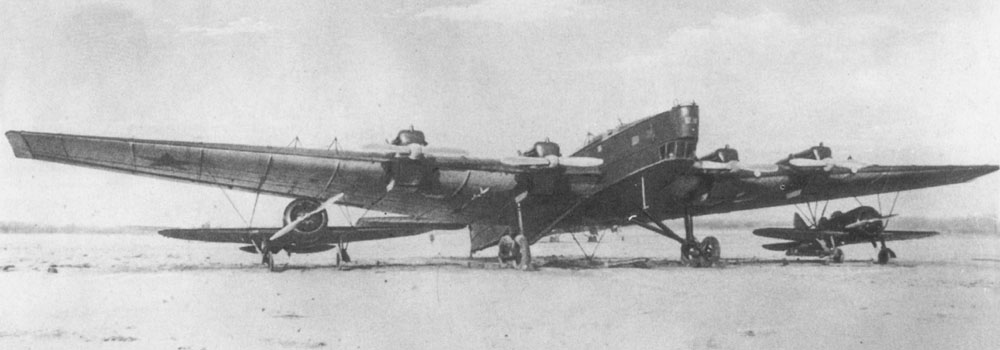 Image from I-16 in
action, Squadron Signal
Image from I-16 in
action, Squadron Signal
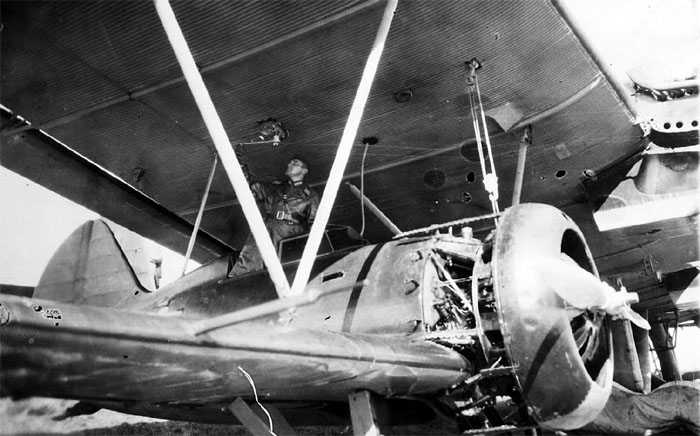
An I-16 Type 14 was lifted with a crankshaft and secured to the strut under the wing of a TB-3.
The fighter was probably of early production of GAZ-39: the side panels of the cowling are removed, but the length of the cowling supports suggest this. Besides, if this plane is the one of the photo above, we can see the blisters for the flares behind the tip of his right wing, as on the prototype. The blisters aren't visible on the right wing of the plane suspended under the left wing of the carrier, marking that it was of somewhat later construction.
A source suggests that the prototype TsKB-12 was involved in these tests, perhaps on the base of the blisters on the wing, but this plane has a straight pitot probe. so it doesn't seem the prototype unless this was updated up to the standard of production planes.
Unusually, the red star is shining and visible on the fuselage; for some reason, it is often difficult to see the markings of the Type 4s.
Another unusual characteristic is the light undersurface of the cowling; it seems that this wasn't painted black as usual.
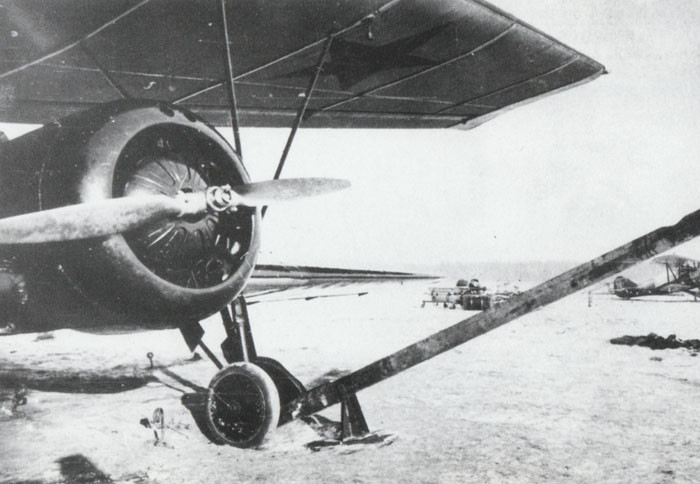
The plane under the left wing of the carrier. The cowling looks painted black, so it could be a plane built in GAZ-21.
Note the shutters in closed position on the vents of the central fairing of the engine.
Image from I-16 in action, Squadron Signal
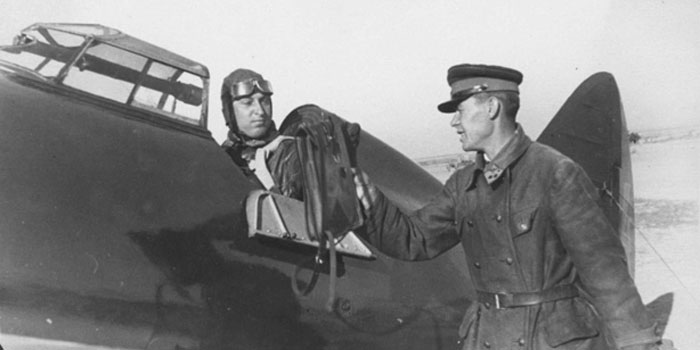
Images from Scalemodels.ru
Very rare image of an operative I-16 Type 4 in summer 1936. The pilot was Ivan Trofimovic Erevenko, commander of commander of 119th air squadron, 70th detached fighter section, Baku. A number 4, probably red with white outline, is barely visible on the rudder. The red stars are not visible, but they had to be there.
The plane can be distinguished from later Type 5 by noting the long metal stripe hiding the hinge gaps between fin and rudder; Type 5 and later types had only two small plates covering the hinges.
Note the wire from the fin to the stabilizator. This was a modification to strenghten the fin, and appears, even if less visible, on other photos too. Probably this modification was refitted to many TsKB-12, Type 4 and UTI-2.
Another difference is the lack of a rubber shield on the OP-1 gunsight to close the gap between the tube and the canopy in closed position, present on Type 5.
The highly polished livery was dark olive green with medium blue undersurfaces and black cowling; the plane was probably built in GAZ-21.
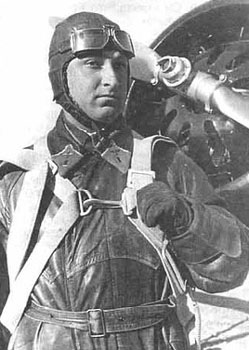
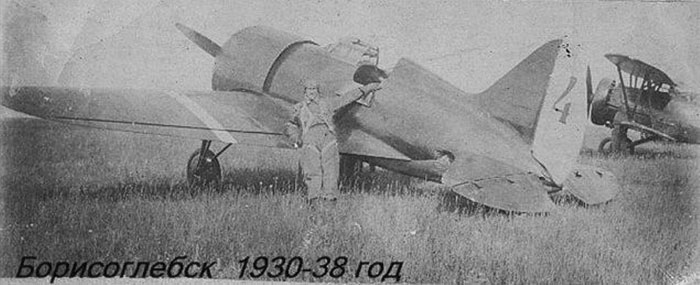
I-16 type 4 of the flight school of Borisoglebsk, in the Voronezh oblast.
One can see the white rudder and bands on the wings. The number seems red with thin black outline. Red stars are not distinguishable, but one cas suppose they were in the usual prewar positions. The engine cowling looks of the same color of the uppersurfaces. Note the lack of doors for the landing gear, that suggests that it could have been locked open.

Interesting image of a plane in service in the '30s.
The photo, although poor, shows clearly an unusual landing gear leg, with the wheels sustained by a fork instead of the usual cantilever pin. A rectangular panel of unclear meaning is visible in front of the leg's vane. The unusual gear seems to have some resemblance to the one installed on the I-163 prototype.
Image: archive Zaika.
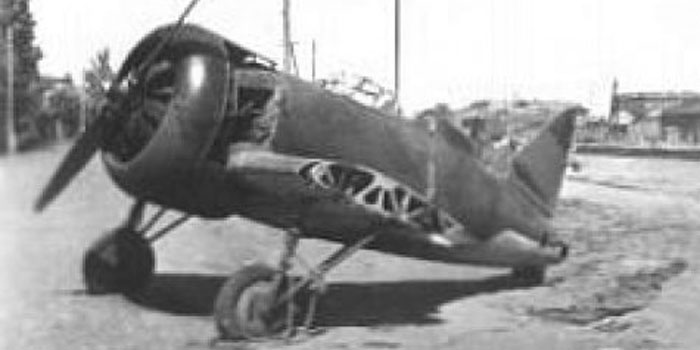
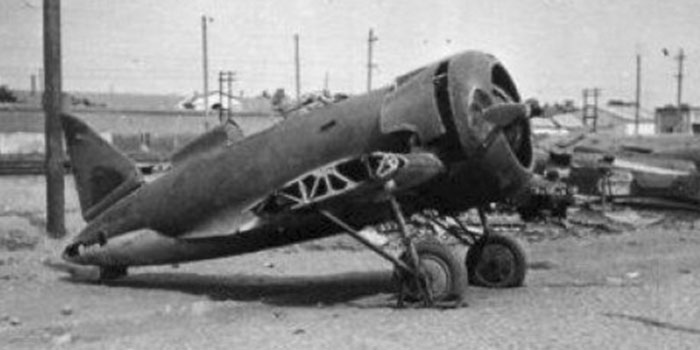
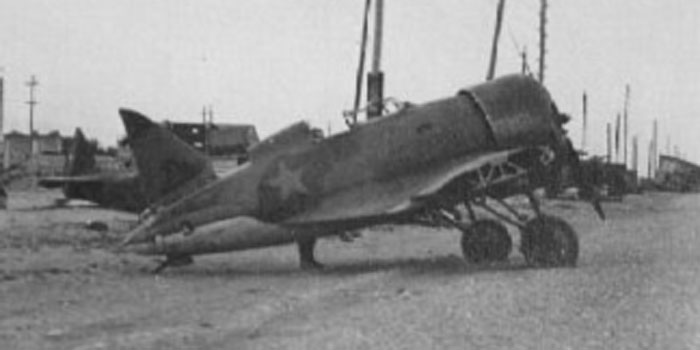
At the beginning of the war, on June 1941, very few Type 4 were still serviceable and forthemost as training planes.
This one, partially dismantled and captured by Germans, bore a very strange polychromatic camouflage, perhaps inspired to the directives of May 1941. If so, it could involve green, very dark brown and light yellowish brown. The national markings likely conformed to the prewar standard, on the fuselage and above/below the wings.
Images from Scalemodels.ru
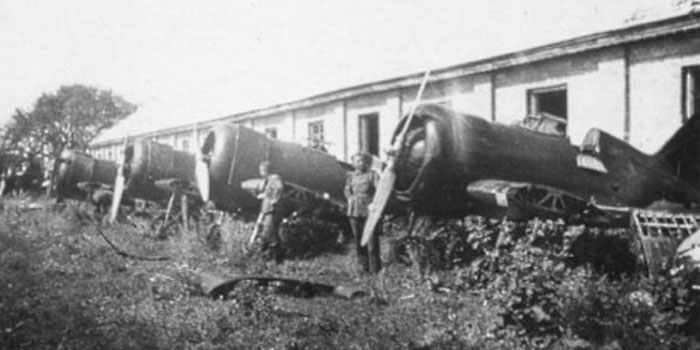
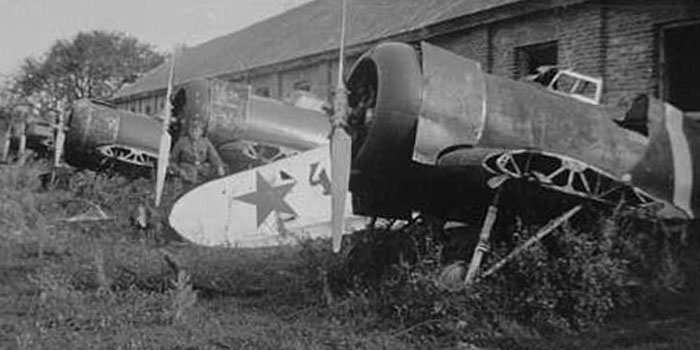
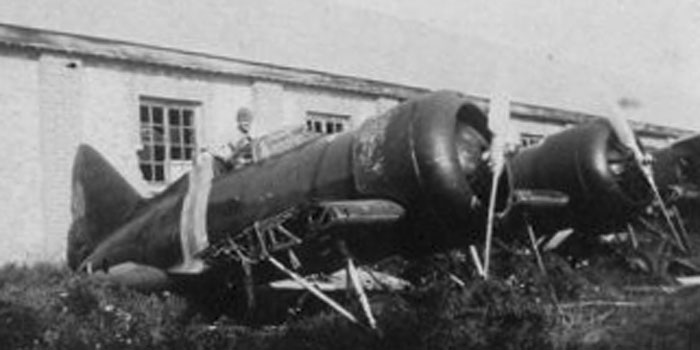
A line of (at least) five partially dismantled Type 4, probably captured in a flight school. It is not clear if they were still serviceable when captured.
Some planes, perhaps all, show a recognition band across the fuselage, this would be expected for a flight school.
Note the wing with a number 4, possibly black.
The plane of the photo below seems to have a recognizable red 4 with white outline on its rudder. The band on the fuselage (white and blue?) seems a recognition mark.
Images from Scalemodels.ru
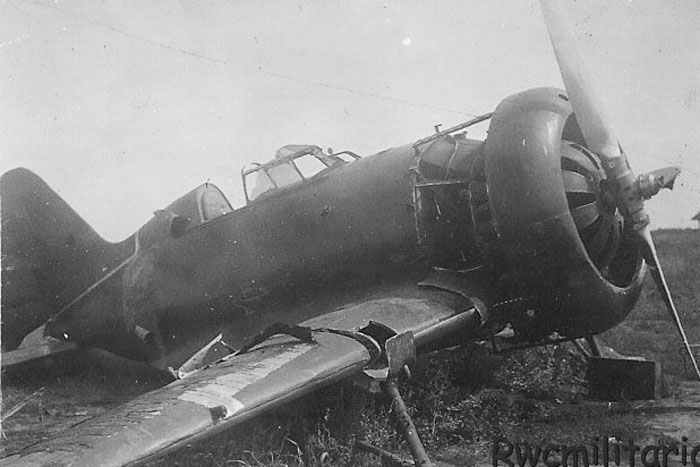
Another wrecked Type 4. Here we see that the fuselage and the wings were partially stripped off of their fabric skinning by souvenir hunters.
Image from the web
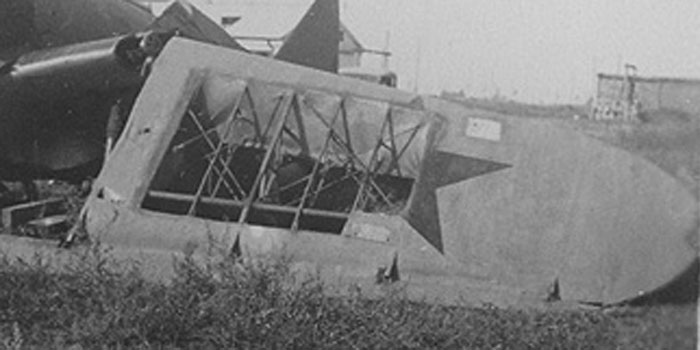
A detail of a wing of a Type 4.
The detail of the protruding hinges of the aileron is noteworthy.
Image from Scalemodels.ru.